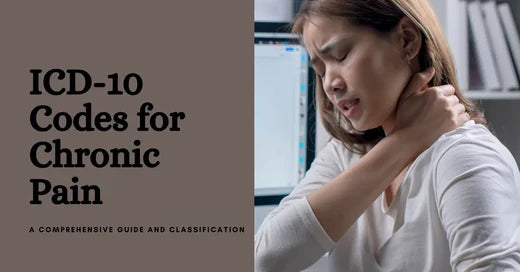
ICD-10 Codes for Chronic Pain: A Comprehensive Guide and Classification
Share
Long-term pain affects millions of people around the world, making life worse every day and more terrible. Healthcare professionals use the ICD-10 codes to better manage and classify these conditions. According to World Health Organization development, the codes are a uniform way of classifying and reporting long-lasting conditions that should trigger thorough pain evaluation and proper patient treatment. This has important implications for patients and providers in developing an understanding of the challenges medico-legal codes pose to two-way communication during care. In this blog, you will learn about different parts of the body where a person can experience chronic pain and how it is treated with the ICD-10 Code.
Table of Contents
Chronic Pain Disorder, ICD-10: An Overview
By using this specific code, healthcare professionals can more accurately diagnose and treat CPD, enhancing communication within the medical team and tailoring care to the individual's needs. This approach helps streamline the management of chronic pain, making the healthcare process more effective and collaborative. As a result, patients are likely to experience better support and have a greater chance of returning to a more fulfilling life.
ICD-10 codes for chronic neck pain

Chronic neck pain can deeply affect daily life and overall well-being, making even simple tasks challenging. ICD-10 codes are crucial tools that help doctors accurately diagnose and treat this condition. For instance, the code M54.2 specifically refers to cervicalgia or chronic neck pain. By using these codes, healthcare providers can communicate about the specifics of a patient's neck pain. This clarity leads to more personalised and effective treatment plans. For patients, understanding these codes can make a significant difference. It helps them grasp their diagnosis better and engage more actively in their treatment process. Ultimately, this improved understanding and communication aim to enhance their quality of life, helping them manage their pain and enjoy a better daily experience.
ICD-10 Code for Chronic Back Pain

Chronic back pain is a condition that many people endure, affecting their ability to perform daily tasks and enjoy life. The ICD-10 code for chronic back pain is M54.5, which specifically denotes low back pain. This coding system helps doctors accurately diagnose the condition and develop effective treatment plans. By using ICD-10 codes, healthcare providers can better communicate about the severity and specifics of a patient’s back pain. For patients, understanding this code can offer a clearer picture of their diagnosis and treatment options, promoting a proactive approach to managing their pain and improving their quality of life. Knowing the code M54.5 can also assist in navigating healthcare systems, ensuring that insurance claims and medical records accurately reflect the patient’s condition. Moreover, having a precise code allows for more targeted research and the development of specialised treatments, ultimately benefiting those who suffer from chronic back pain. Patients are encouraged to discuss this code with their healthcare providers to fully understand their condition and explore the most effective strategies for pain relief and management. By staying informed and engaged, patients can take an active role in their healthcare journey, working alongside their providers to achieve better outcomes.
ICD-10 Codes for Chronic Pelvic Pain
Chronic pelvic pain is a condition that can deeply affect a person’s life, making daily activities difficult and often leading to emotional distress. The ICD-10 code for chronic pelvic pain is R10.2. This code is crucial for doctors to accurately diagnose and treat the condition, ensuring patients receive the care they need. For patients, understanding this code can be empowering. It provides a clear label for their pain, which can help in communicating with healthcare providers and navigating the healthcare system. Knowing the ICD-10 code R10.2 can also make it easier to manage insurance claims and medical records, ensuring that all aspects of the condition are properly documented. Beyond the practical benefits, having a specific code.
ICD-10 Codes for Chronic Shoulder Pain
Chronic shoulder pain can make everyday activities a struggle, impacting everything from reaching for a shelf to simply getting dressed. The ICD-10 codes for chronic pain in the right shoulder pain, such as M25.511 for pain in the right shoulder and M25.512 for pain in the left shoulder, help doctors diagnose and treat this condition accurately. For those who experience chronic shoulder pain, understanding these codes can be incredibly beneficial. These codes ensure your pain is properly documented, which is important for insurance claims and creating effective treatment plans. Knowing these specific codes allows you to have a more informed discussion with your healthcare provider, leading to personalised and effective care. Furthermore, the use of precise ICD-10 codes means that chronic shoulder pain is recognized as a serious condition, prompting more research and better treatment options. Patients should feel empowered to talk about these codes with their doctors, gaining a deeper understanding of their condition and exploring the best ways to manage their pain. Being informed about these codes helps you take an active role in your healthcare, ultimately aiming for improved pain management and a better quality of life.
Conclusion
Chronic pain affects millions of people around the world, making life very difficult. Healthcare professionals use the ICD-10 to better manage and classify these conditions, which are triggered through pain evaluation and proper patient treatment. Using specific codes, healthcare professionals can more accurately diagnose and treat CPD, enhancing communication within the medical team and tailoring care to individual needs. As a result, patients are likely to experience better support and have a greater chance of returning to a fulfilling life.
Frequently Asked Questions
Q. What is the ICD-10 code for chronic pain?
Chronic pain disease (CPD) is a pervasive and complex condition that poses significant challenges for those who suffer from it, often leading to considerable financial strain. The introduction of the ICD-10 code F45 for CPD is an important step towards improving how this condition is identified and managed. This code reflects the intricate nature of chronic pain and supports a variety of treatment approaches, acknowledging that there's no one-size-fits-all solution.
Q. How do you code chronic pain?
Chronic pain can be a constant struggle, impacting every aspect of life. To ensure proper treatment, doctors use ICD-10 codes to classify chronic pain accurately. For general chronic pain, the code is G89.29. This code helps healthcare providers create effective, personalized treatment plans and ensures that your pain is taken seriously. Knowing this code can also make insurance and medical records easier, giving you a clearer path to the care you need.
Q. What is considered as chronic pain?
Pain is a relentless shadow that follows millions of people every day. It’s the ache that never truly leaves, the sharp reminder with every movement, and the invisible burden that can’t be seen. It is the body's natural reaction to an injury or illness.
